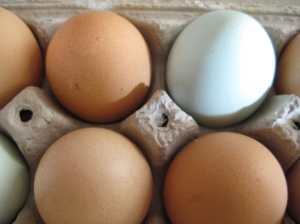Part 6 (and final) in a series on bread and baking.
This post is not about bread. It certainly has a place in this series, but it is not about bread, or even about baking.
What does it mean to be gluten-free and celebrating Passover? On Passover we clean our homes of hametz, anything yeast-leavened made from the five grain species: barley, rye, oats, wheat, and spelt. Anyone gluten-free knows that those are precisely the grains we are already avoiding 365 days per year. The only permissible form of food made from these grains is matzah, which has to be baked for 18 minutes or less. According to Jewish law, Jews are not permitted to own or eat any hametz during the eight days of Passover.
OK, so what. I’m one step ahead of you all!
The focus of Passover for me, growing up, was about restrictions. In addition to the restrictions on bread, pasta, and other yeast-leavened foods, because we were Ashkenazi (descendants of Jews from Eastern Europe), we were also restricted from eating kitniyot, which includes legumes, rice, and seeds. This meant Passover was eight days of being perpetually hungry. For a lot of Jews, Passover is akin to Yom Kippur.
But Passover is also the holiday of spring and rebirth! Such symbolism and beauty.
For me, the last few years of eating gluten-free have also coincided with my own development of a deep love and understanding of local food, which came with a new appreciation for the rhythm of the seasons. In Boston, spring means that crocuses have come up, daffodils are blooming (a little too early this year), perennial greens are returning. It also means that my farmer friends are starting seedlings in their greenhouses, and work crews return to the farm to begin cultivating the soil and readying the land for the new growing season.
Passover has become a time to focus not on food restrictions, but on the miracle of the shifting of seasons that turns snowy fields into homes for thousands of plants in a matter of months.
In her book Full Moon Feast: Food and the Hunger for Connection, Jessica Prentice writes a chapter on The Egg and its symbolism in spring. On chicken farms, springtime means an increase in egg production, as light stimulates hens’ pituitary gland to produce a hormone that stimulates their ovaries to produce eggs. (My farmer friend M was telling me yesterday that their chickens are producing so many eggs right now that they can’t keep up.). Factory egg farming increases production by lighting the factory 24 hours a day, creating a sort of perpetual summer for the hens. Adding antibiotics to the mix ensures a standard egg production all year round. But at small farms with actual free roaming chickens, springtime is truly when egg production booms.
Eggs are a common springtime symbol, including in the big spring holidays of North America, Passover and Easter. Prentice writes, “Eggs, like seeds, are symbolic of hope and of a future that is fertile with life. They are an ancient icon of spring, rebirth, and renewal.”
As we move from winter, the season of scarcity, to spring and summer, seasons of abundance, let’s reframe Passover not as a time of restriction but as one of hope and abundance. Anyone with food restrictions (including gluten) can tell you that life is vibrant, colorful, and more fun when we focus on the abundance of foods that we can eat, instead of the ones we can’t. Enjoy the new greens, the richness of springtime eggs, and revel in the miracle of changing seasons.





